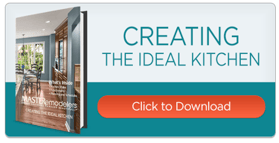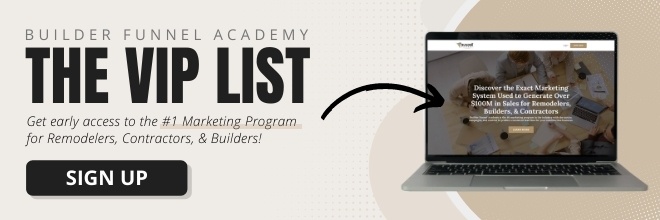6 min read
How to Attract Qualified Leads for Builders, Remodelers, and Contractors
By: Steven Fielding on Mar. 27, 2018

A simple title for a not-so-simple topic - How to Find Qualified Leads for Builders, Remodelers, and Contractors.
Every lead is different just like every house is different.
Some leads are just beginning research for their upcoming project. Some know what they want but can't decide on a company, and other leads know exactly what they want and are ready to move forward right away.
In a perfect world, we would only attract and convert leads at the bottom of the funnel - the ones that are ready to remodel or build and their only question is "When can you start?". Of course, this isn't the case most of the time. We won't always attract leads that are at the bottom of the funnel, but this doesn't mean we can't improve our marketing systems to attract fewer unqualified leads and more qualified leads.
In this blog post, we'll cover how to attract more qualified leads and fewer unqualified leads while not excluding any part of your audience that could have the potential to purchase. Let's get started.
1. Being Honest
The first step to attracting qualified leads is being honest. What does this mean? It means providing accurate photographs of your work on your website, clearly describing your unique process for building or remodeling, being up front and open about cost, and not trying to trick your audience into giving up their information or contacting your business.
Scenario 1: Accurate Photography
 You go to a home builder's website, you see they have a low price point which works for you. There home photos are also gorgeous! However, after you begin the conversation, you realize those photos don't accurately represent the builder's work. They're either stock photos or represent homes with tons of upgrades (which you can't afford). Now, you either need to decide if you're going to pay way more for a home or to start over.
You go to a home builder's website, you see they have a low price point which works for you. There home photos are also gorgeous! However, after you begin the conversation, you realize those photos don't accurately represent the builder's work. They're either stock photos or represent homes with tons of upgrades (which you can't afford). Now, you either need to decide if you're going to pay way more for a home or to start over.
Accurate photography helps you attract the ideal buyers to a specific business. We don't want to misrepresent work or try to trick the audience.
Scenario 2: Being Up Front and Open
You're ready to remodel your kitchen. You contact a contractor and go through the initial consultation. You have subsequent meetings. However, once the it comes down to cost, you find out they are way more expensive than you can pay. Now, you're upset because you felt like cost was not accurately discussed up front. Situations like this can be easily avoided if the contractor thought about the most common questions, concerns, and information that potential customers ask for and discussed it openly on the website or in other documentation.
Honesty in your branding and messaging will clearly tell unqualified leads that you aren't the right match for them and tell qualified leads that you could be a good choice, and at the end of the day, they will appreciate your transparency.
2. Providing the Right Offers
When you are trying to attract qualified leads online or in person, you need to have the right incentives. For example, a new home package including many discounts and additional deals may be better suited for leads looking in a lower price point. The higher the cost, the more the incentives change.
Scenario 1: Minimal Offers
 No matter what stage your website visitors are at in the buying cycle, there are offers that you can provide to help them make informed decisions. Offers can range from a free eBook about kitchen remodeling to help a prospect do research to a consultation offer. You can see examples of a kitchen eBook offer including the CTA (call-to-action) above and a landing page (below).
No matter what stage your website visitors are at in the buying cycle, there are offers that you can provide to help them make informed decisions. Offers can range from a free eBook about kitchen remodeling to help a prospect do research to a consultation offer. You can see examples of a kitchen eBook offer including the CTA (call-to-action) above and a landing page (below).

If you don't provide any opportunities for your visitors to convert into leads on your website, they won't.
Scenario 2: You Don't Ask Anything of Your Audience
Similar to providing not providing any offers, you need to ask your audience to take actions. This could be anything from viewing a photo gallery to downloading an eBook to scheduling a meeting. Don't be afraid of asking them to do stuff on your website. Remember to approach this situation as a helpful guide. Think about why someone should care about x, y, or z thing you're doing or asking them to do, and guide them in the right direction not because you're forcing the sale but because you want to help.
Scenario 2: Forcing the Bottom of the Funnel
Speaking of forcing the bottom of the funnel, you don't only want offers like "Schedule a Consultation" and "Contact Us." We shouldn't always be backing our audience into a corner and trying to force them to buy. This will scare a lot of people away. Instead, we should provide the right offers at each stage of the funnel.
- Example 1: A lead is just researching so you give them checklist on choosing a contractor.
- Example 2: A lead now evaluating contractors so you give them a complete guide to your company's process.
- Example 3: That lead has been qualified (you asked the right questions). They have the budget, and they're interested in talking to you. You offer to meet with them.
Someone looking to build a house or remodel in the millions will probably be less impressed by "10% off" or "free upgraded shower tile." They may be more concerned with getting exactly what they want for the price they pay. To encourage them, the offers should alleviate their fears.
3. Asking the Right Questions
Scenario 1 - Asking Too Many Questions on Your Forms
A lead is on your website looking around. You offer a Kitchen Remodeling eBook that targets leads during the research phase. This lead just happens to be in that phase, and they are your ideal customer. However, they don't download the eBook because we asked for not only name and email but budget, timeline, and many other middle to bottom of the funnel questions in our form. We missed an opportunity to convert and then nurture that lead.
Scenario 2 - Asking Too Few Questions
In another scenario, your contact form only includes first name, last name, email, and a message box. You get many submissions, but you have to waste valuable time following up and many of them aren't qualified. This is likely because the form is too simple. By adding more qualifying questions to your contact form, you will save time and effort and know that most of the leads filling out that specific form will be qualified or easily sorted.
Scenario 3 - The Right Questions at the Right Time
A lead visits your website during the research phase. They find an eBook on remodeling their kitchen which is what they eventually want to do. You ask for first name, last name, email, and phone number. The offer is enticing and has the information they need to research their upcoming project. They download. You send them their offer with a follow-up email.
Over time, they receive your marketing emails, read your blog posts, and continue to wait for the right time. The time arrives. They go to your contact page because they've been following you for awhile and fill out the contact form with their timeline, budget, type of project, and many other qualifying answers to your questions. They do move on to become a customer, but this would have never happened if we scared them away with too many questions too fast or didn't ask the right questions to qualify them later.
4. Having a Qualification Process
The final point I want to make is that if you have a air-tight qualification process that will then carry over into attracting qualified leads. If you know what questions you ask to qualify, you can ask them at the right stages of your funnel. If leads that are unqualified slip past, you will easily be able to sort them.
Scenario 1: Over-Qualification
Many contractors, remodelers, and home builders are afraid of wasting their time with leads so they over-qualify. They try to get as much information from a new lead as possible so they can identify if they are a good fit. If you try to do this during the top or even the middle of the funnel, leads may become skittish and avoid interacting with your offers. One of those leads might have wanted a $1,000,000 project but was just researching so didn't want to answer the many, many questions on your contact form. Ask the appropriate amount of qualifying questions at the right stages of the funnel.
Scenario 2: Under-Qualification
You want to contact this remodeler whose website you're browsing. You go to the contact page and fill first name, last name, email, message. Great! You have your first call with the company, and they ask a few general questions (but not big ones like budget). You have a second meeting. By this point, you really like them. However, they then ask your budget, timeline, and other big questions. Turns out you're not they're customer. Now, both parties have wasted time.
Once again, ask the appropriate questions at the appropriate times.
We should constantly be asking if a piece of content, offer, eBook, form, or other element on our website or other online medium helps qualify our leads and move them down the funnel. If any of these elements does not serve our audience by either telling them "This isn't the right business for me," "This could be the right business for me," or "This is definitely the right business for me," we should discard it.
I hope this post will help you carefully consider how you are currently capturing leads, qualified or unqualified. If you have any of your own tips for attracting qualified leads for your remodeling, home building, or contracting company, I would love to hear about them. Leave a comment below to share!



